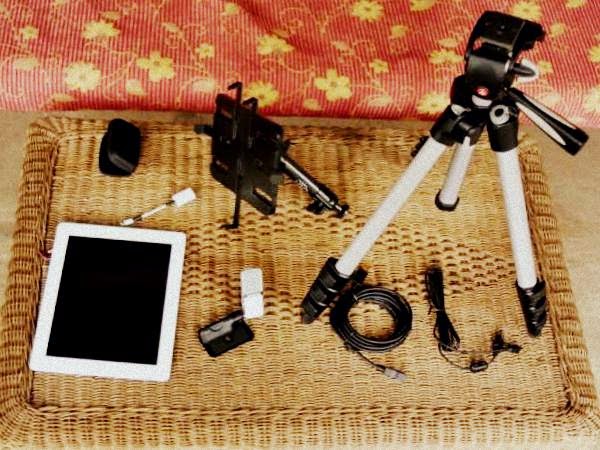We've been quite interested to see what mobiles and tablets give in terms of workflow, in field conditions. Rick Goldsmith of Catcher Media has been using ipads in workshops for some time now, and he's built up a nice set of accessories that bridge the gap between a handheld ipad and something a group can work with and hope to get good sound. This kit was based on what he's learned so far.
The mic allows for direct monitoring with headphones, and can be mounted on a boom pole for 2 person operation. This gives a lot of flexibility as one can move from a handheld solo ipad to a set up that works reasonably well for interviews. We didn't buy a specific tripod and boom pole for this project, but the lightweight one here is fine (from my DSLR travel kit). A lighter boom pole would have been quite feasible, and would have given a nicely portable overall weight of kit. An alternative to the tripod and tripod mount would be some kind of clamp, which would again cut down on weight and size by replacing the tripod with door frames, chairs or whatever else offers a stable edge to clamp on to.
In terms of apps, we have a number loaded on, but these three are the key ones we've used so far. iMovie is very intuitive, but the Pinnacle app adds a few more features (separating out sound tracks, for example) which give a little more scope without being hard to use. Videon offers more creative control and even some simple editing facilities like splitting clips and colour correction.
The advantages:
Overall we think there's a lot to be said for this set up for building up skills. It's not quite as satisfying for group work or for introducing video controls as camcorder based setups, but that might just be the way we're used to working.
I'm going to post this any any kit reviews on a separate blog as well - http://pvkit.blogspot.com/, which I'd like to keep going beyond this project. It'd be great if any other PV practioners out there would like to share what they've found too. Leave a comment on the blog or email me if you'd like to be invited to be a contributor.
The basic kit, consists of:
- iPad
- A USB mic
- Cables: lightning-USB converter, USB cable, USB extension
- A Joy Factory Unite tripod mount
- Lightweight tripod
- Headphones
- Boom pole.
Apps on the ipads:
- iMovie
- Pinnacle Studio
- Videon
The mic allows for direct monitoring with headphones, and can be mounted on a boom pole for 2 person operation. This gives a lot of flexibility as one can move from a handheld solo ipad to a set up that works reasonably well for interviews. We didn't buy a specific tripod and boom pole for this project, but the lightweight one here is fine (from my DSLR travel kit). A lighter boom pole would have been quite feasible, and would have given a nicely portable overall weight of kit. An alternative to the tripod and tripod mount would be some kind of clamp, which would again cut down on weight and size by replacing the tripod with door frames, chairs or whatever else offers a stable edge to clamp on to.
In terms of apps, we have a number loaded on, but these three are the key ones we've used so far. iMovie is very intuitive, but the Pinnacle app adds a few more features (separating out sound tracks, for example) which give a little more scope without being hard to use. Videon offers more creative control and even some simple editing facilities like splitting clips and colour correction.
The advantages:
- Ease of use - shooting and editing both take very little time to introduce, even with a group who're not really familiar with technology interfaces and controls. We were really struck on this project with how quickly participants took to editing.
- Can monitor sound (the mic has a headphone socket) and image (the screen is a nice size to see the shots).
- Can shoot, edit and review on the same device. It can also play out to a projector, or files can be shared between ipads or transferred to laptops for further editing (more on this separately).
- There was a lot of interest in the ipads from participants, and request to have extra time playing with them, which we regard as a very healthy sign.
- They work for small group work (3-4) people. We've used them for interview practice and small two shot dramas. These play to the strengths of the device without making difficulties
Issues we've run into
- The lightning to USB connection comes loose a little too easily for comfort.
- Reflections obscuring the image on screen while filming outdoors
- The clamp can be a bit fiddly to fit on the the ipad so as to leave the lightning port free. Rick had to drill a hole in it to be able to use an ipad mini camera as otherwise this would be covered over.
- The controls in the basic camera app are quite primitive, and it 's very easy to get mixed up between shooting modes and record photos rather than video clips (for example).
I'm going to post this any any kit reviews on a separate blog as well - http://pvkit.blogspot.com/, which I'd like to keep going beyond this project. It'd be great if any other PV practioners out there would like to share what they've found too. Leave a comment on the blog or email me if you'd like to be invited to be a contributor.



No comments:
Post a Comment